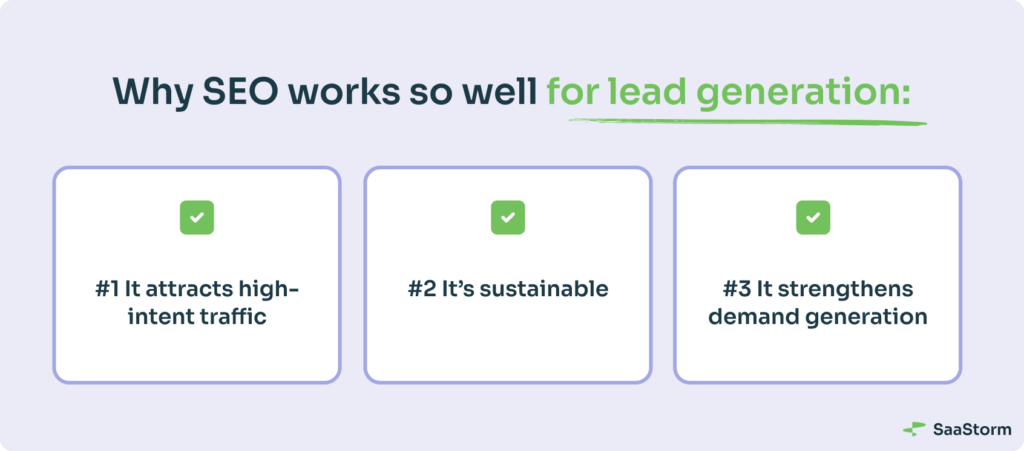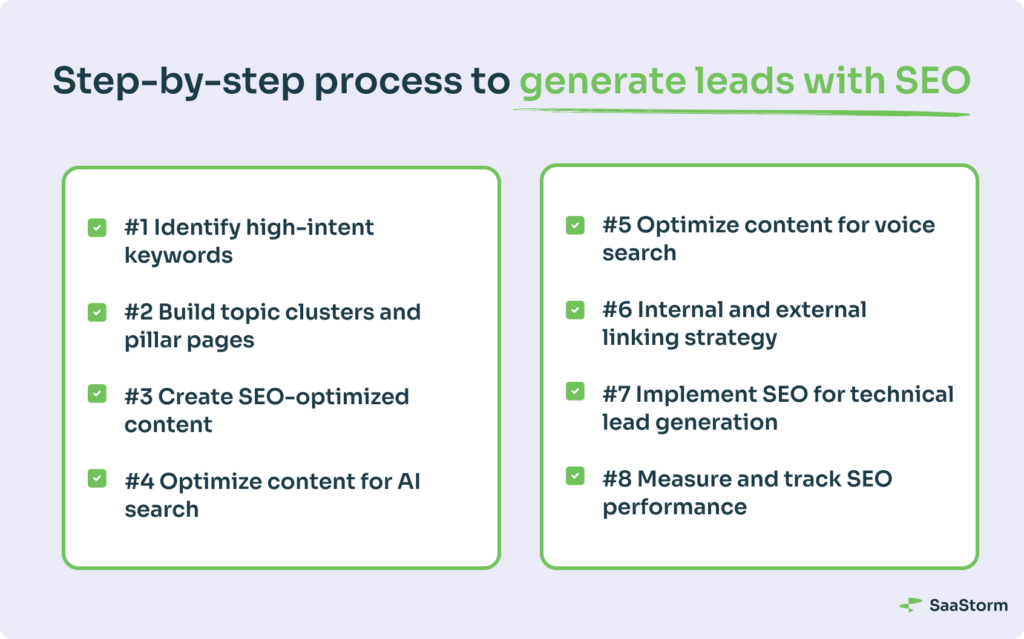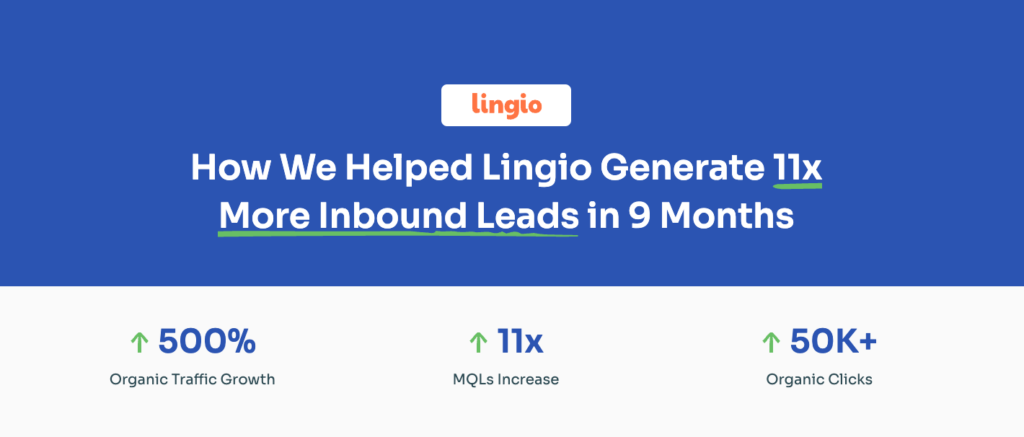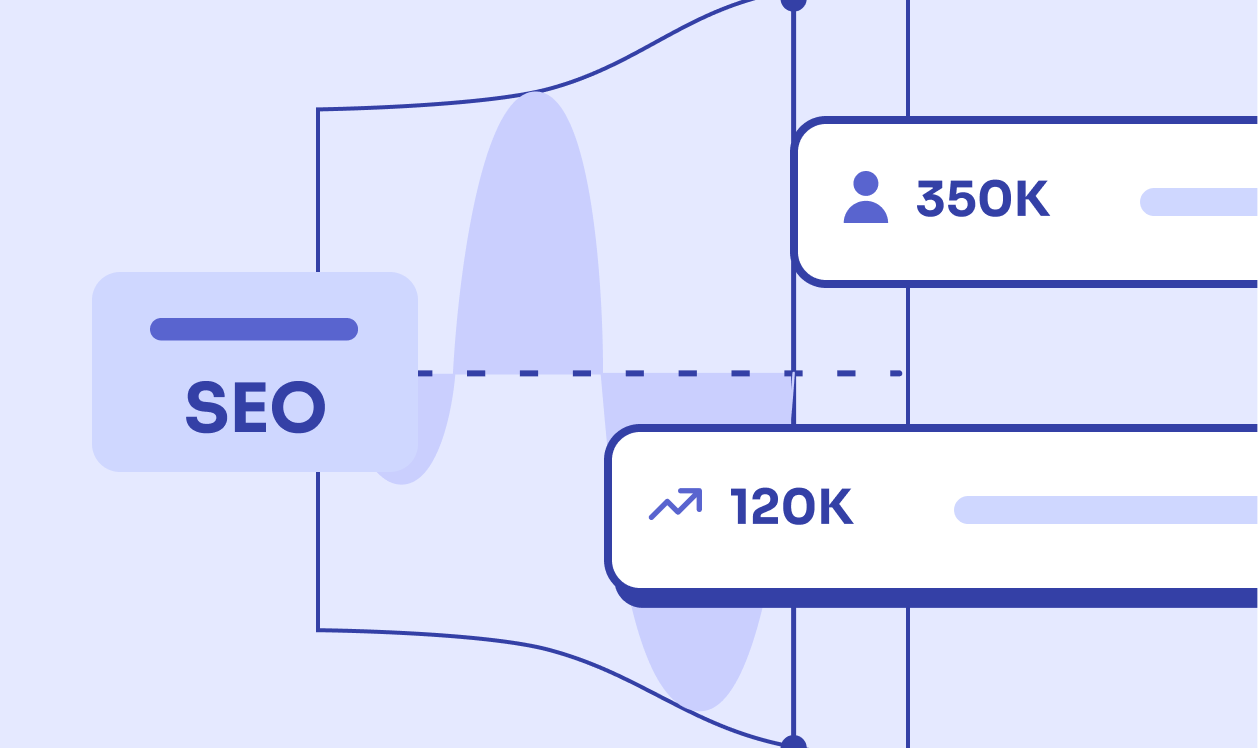Effective SEO for lead generation in B2B SaaS focuses on attracting high-intent visitors and converting them into pipeline. This means targeting problem-aware and solution-aware keywords, building conversion-optimised content, and using clear CTAs, gated assets, and retargeting flows. It’s about quality over quantity – driving leads that actually close, not just traffic that reads.
Before you throw money at your next Google Ads campaign, consider upping your SEO game. Why? It’s like throwing a party: you don’t just want a crowd; you want the guests who stay and make it memorable.
Take Lingio, for example. They started with an empty blog and no visibility in search engines. After implementing a tailored SEO strategy, they achieved a 500% growth in organic traffic and an 11x increase in MQLs in just nine months.
In this lead generation SEO guide, we’ll show you how to generate leads with SEO by combining demand generation and targeted content strategies.
We’ll cover proven strategies, actionable steps, and real-world examples to help you attract the right audience and grow your online business.
Why SEO is a powerful lead generation strategy
What is SEO lead generation? It’s the process of attracting, nurturing, and converting high-intent traffic into qualified leads using organic search.
Paid ads might bring you quick wins, but they stop working the moment your budget runs out. SEO? That’s your long-term strategy.
Here’s why SEO works so well for lead generation:

1. It attracts high-intent traffic
These aren’t random clicks. People searching for terms like “best B2B SaaS tools for lead generation” are already halfway down the funnel. They’re looking for solutions—yours.
Learning how to generate more leads through SEO is all about refining your strategy to get target keywords and high-intent traffic that converts.
2. It’s sustainable
SEO keeps working, even when budgets are tight. Unlike paid ads, it builds momentum over time, delivering consistent results long after the initial effort.
Knowing how to generate leads through SEO means building a strategy that prioritises both search engine visibility and user experience.
3. It strengthens demand generation
Pairing SEO with demand generation helps you capture and convert leads with a strategy built for long-term growth.
The good news? You don’t need to start from scratch. With the right approach, SEO can deliver faster results than you’d expect.
Here’s how we’ve done it for other B2B SaaS companies like yours.
SaaStorm’s proven SEO lead generation strategy
We don’t believe in cookie-cutter solutions because your business deserves better. How to generate leads in SEO comes down to targeting the right audience at the right time with the right content.
B2B SEO strategies for lead generation are tailored to your business goals and audience needs.
Take Lingio, for example:
- Grew organic traffic by 500%.
- Increased MQLs 11x in just nine months.
- Published 125+ SEO-optimized content pieces to dominate their niche.
What makes our approach different?
- It’s data-driven. Every keyword, topic, and piece of content is chosen for its potential to drive high-intent traffic.
- It’s scalable. We build systems that grow with your business, not just quick wins that fizzle out.
- It’s proven. Our case studies, like Lingio and Reditus, show exactly what’s possible with the right strategy.
By focusing on strategies that balance technical SEO, high-quality content, and demand generation, we can help turn your traffic into results.
Curious to see how we’d do it for you? Let’s break it down step by step.
Step-by-step process to generate leads with SEO
Achieving 10x more MQLs isn’t magic—it’s strategy. Here’s how to take a focused, repeatable SEO approach that delivers real business results.
Effective SEO lead generation techniques include building topic clusters, optimising for voice search, and prioritising technical SEO.
Let’s break that down into eight steps:

Step 1: Identify high-intent keywords
Not all keywords are created equal. To execute SEO leads generation, you need to target relevant keywords that your ideal prospective customers are searching for when they’re ready to act.
Let’s make SEO your most powerful lead generation tool!
Schedule a Call- Focus on MOFU and BOFU keywords. These are the terms buyers search as they evaluate options, like “best B2B SaaS tools for lead generation” or “how to choose a sales automation platform.” Understanding how to generate SEO leads starts with targeting high-intent keywords that align with your audience’s needs.
- Use the right tools. Platforms like Ahrefs, SEMrush, and Google Keyword Planner help you uncover keywords that drive traffic and conversions.
- Solve problems. Keywords that address pain points or offer actionable solutions are the ones that convert best.
Pro Tip for B2B SaaS: use competitor keyword research to find gaps in their keyword strategy and make those your wins.
Once you’ve locked in the right keywords, it’s time to build a structure that drives both traffic and conversions. This is where topic clusters and pillar pages take the spotlight.
Step 2: Build topic clusters and pillar pages
Your website shouldn’t just be a collection of blog posts. To generate leads effectively, you need to create a strategic content hierarchy.
Not sure how to generate leads through organic SEO?
- Start with a pillar page. Consider this your ultimate guide on a high-intent topic like “SEO for B2B lead generation.” It’s detailed, comprehensive, and designed to rank for competitive keywords.
- Support it with topic clusters. Create related blog posts that dive deeper into subtopics, like “SEO lead generation tips” or “How to generate more leads through organic SEO.” Link these back to your pillar page to build authority.
- Use real-world examples. Lingio’s success was built on topic clusters that positioned them as a trusted resource in their industry.
Pro Tip for B2B SaaS: Internal linking isn’t just about SEO — it keeps readers engaged and moving through relevant content on your site.
Once your topic clusters and pillar pages are in place, the next step is creating content that delivers value—not just for search engines but also for your readers.
Step 3: Create SEO-optimized content
Content is the backbone of your SEO strategy, but it’s not just about cramming in keywords. Your content needs to be engaging, informative, and optimized to rank.
Curious about how to generate leads from SEO? The key is crafting content that solves real problems and addresses specific pain points.
- Write for humans first, search engines second. Focus on solving problems and answering questions your audience cares about.
- Follow SEO best practices. Use clear meta tags, headers, and internal links to make your content easy to read and rank.
- Score it for success. Tools like SurferSEO can help you hit an 80+ content score for better visibility.
Don’t forget: avoid keyword stuffing — it hurts readability and your rankings. Stick to natural language that flows well.
Creating great content is just the start. To stand out in today’s evolving search landscape, you need to optimize for the latest trends—starting with AI-powered search.
Step 4: Optimize content for AI search
Google’s Search Generative Experience (SGE) is reshaping how search engine results pages and results appear, and your content needs to keep up. This is where Answer Engine Optimisation in SEO plays a key role, helping your content stand out in AI-powered search results.
We can optimise your content for AI search! Want to chat?
Schedule a Call- Use clear, structured headings. Well-organized H1s, H2s, and H3s make it easier for AI to understand and highlight your content.
- Answer questions directly. Bullet points, short paragraphs, and concise answers can help your content appear in featured snippets.
- Embrace semantic SEO. Write naturally, using related keywords and phrases that align with how people search.
- Add FAQs to every page. Answering common questions boosts your chances of showing up in conversational search results.
Pro Tip for B2B SaaS: think of AI search as your chance to be the answer, not just an option.
With AI-powered search covered, it’s time to look ahead to the next big shift in how people find information: voice search.
Step 5: Optimize content for voice search
Voice search is changing the way people interact with content. If you’re not preparing for this shift, you’re leaving potential leads on the table.
- Focus on question-based queries. People use voice search conversationally, asking questions like “What’s the best SEO strategy for lead generation?”
- Use a natural, conversational tone. Write the way people speak to make your content voice-search-friendly.
- Leverage schema markup. Structured data helps search engines understand your content, improving your chances of ranking in voice search results.
Pro Tip for B2B SaaS: prioritize long-tail keywords and phrases—they align perfectly with how people ask questions out loud.
Voice search optimization gets you heard, but to truly maximize your efforts, you need a solid linking strategy. It’s time to connect the dots.
Step 6: Internal and external linking strategy
Businesses wondering how to generate leads via SEO often overlook the importance of internal and external linking strategies.
Links are the backbone of your SEO strategy, guiding both search engines to web pages and users through your site. A B2B SaaS link building agency, like SaaStorm, can help you get it right the first time. Here’s how:
Internal linking:
- Connect relevant blog posts to key landing pages, like product demos or pricing pages.
- Use descriptive anchor text that tells both users and search engines what to expect.
- Keep readers engaged by linking to deeper content, like case studies or guides.
External linking:
- Build high-authority backlinks by guest posting or securing PR coverage.
- Collaborate with partners or influencers in your industry to boost credibility.
- Focus on quality, not quantity—links from reputable sources matter most.
Pro Tip for B2B SaaS: think of links as your site’s roadmap. Done well, they guide users seamlessly and boost your search rankings further.
Now that your SaaS link building strategy is solid, it’s time to get technical. This is where behind-the-scenes optimizations can take your own lead generation process to the next level.
Step 7: Implement SEO for technical lead generation
Even the best content can’t perform if your website isn’t technically sound. Here’s how to ensure your site is working as hard as your content:
- Optimise for site speed. A slow website doesn’t just frustrate users—it also hurts your rankings. Use tools like Google PageSpeed Insights to identify and fix performance issues.
- Prioritise mobile-friendliness. More users are searching on mobile than ever before. Make sure your site is responsive and easy to navigate on smaller screens.
- Nail your Core Web Vitals. Metrics like loading time, interactivity, and visual stability are key ranking factors you can’t ignore.
- Use structured data and schema markup. Help search engines understand your content by tagging key elements like FAQs, ratings, and product details.
Pro Tip for B2B SaaS: a technically optimised site doesn’t just improve rankings — it creates a seamless experience for users, which leads to more conversions.
You’ve tackled content, links, social media marketing, and technical SEO. Now, it’s time to measure your efforts and track the results that matter most.
Step 8: Measure and track SEO performance
You can’t improve what you don’t measure. Tracking the right metrics ensures your SEO strategy stays on target and delivers results.
Keep an eye on these KPIs:
- Organic traffic growth: Are more people finding your site?
- Keyword rankings: Are you climbing for high-intent search terms?
- MQLs and SQLs: Is your traffic converting into leads and opportunities?
- Pipeline revenue: How much revenue can be attributed to SEO efforts?
- Conversion rates: Are your pages turning visitors into leads?
Use the best SaaS SEO tools:
- Google Analytics and Search Console for traffic insights.
- SurferSEO for content performance.
- HubSpot or similar CRM tools to connect leads to SEO campaigns.
Pro Tip for B2B SaaS: schedule regular performance reviews to refine your strategy and identify new growth opportunities.
It’s one thing to talk about effective digital marketing strategies—it’s another to see them in action. Let’s look at how we helped Lingio turn an empty blog into a lead generation digital marketing powerhouse.
SaaStorm’s Lingio case study: 11x MQLs in 9 months
When Lingio, a fast-growing SaaS company, approached us, they had a big problem: an empty blog and little visibility in search engines. Despite having a great product, they struggled to attract the traffic that drives meaningful leads from potential customers.
That’s where we came in.

The challenge
Lingio needed a way to cut through the noise in a competitive market. With no established content foundation and low search visibility, they weren’t reaching their ideal audience—or generating the leads they needed to grow.
The solution
We built an SEO-driven content marketing strategy from the ground up. Over nine months, we:
- Published 125+ SEO-optimised articles tailored to their audience’s needs and search intent.
- Created strategic topic clusters to target high-intent keywords.
- Focused on scaling their traffic while improving lead quality.
The results
The numbers speak for themselves:
- 500% growth in organic traffic—more people finding their site than ever before.
- 11x increase in MQLs—qualified leads ready to engage.
- 50,000+ organic clicks—each one bringing them closer to their goals.
I’m very impressed with the results we’ve achieved together with the SaaStorm team. Our organic traffic has grown by 500% in just 9 months, leading to an 11x increase in incoming leads.
— Fredrik Selander, Head of Marketing at Lingio
This case study shows how powerful SEO can be in generating leads, driving organic web traffic, and building a sustainable lead generation engine that kept delivering long after the initial strategy was implemented.
Lingio’s success isn’t just a one-off. With the right partner and a tailored strategy, you can turn SEO into a consistent, scalable lead generation engine for your business, too.
We know you want the same results as Lingio!
Schedule a CallOver to you: Time to build the SEO strategy your business deserves
SEO isn’t just about rankings—it’s about creating a lead generation engine that works for your business. With the right strategy, you can attract the traffic that matters and turn it into real growth.
You don’t have to do it alone. Partnering with a B2B SaaS SEO agency like SaaStorm can help you skip the trial-and-error and focus on strategies that deliver scalable results.
Want to learn more?
- Check out our in-depth B2B SaaS SEO guide
- See how we helped Reditus achieve their lead generation goals
Time to make SEO your most powerful lead generation tool Let’s get started.
Schedule a CallFrequently asked questions about SEO for lead generation
SEO is a long-term strategy. While you might see improvements in website traffic, and rankings within 3-6 months, generating consistent, high-quality leads can take 6-12 months, depending on your niche and competition.
It’s best to create content that solves your own target customers or audience’s problems or answers their questions. Think guides, case studies, how-tos, and FAQs. Focus on MOFU and BOFU SEO content that aligns with search intent and drives conversions.
Absolutely. By targeting niche, high-intent keywords and focusing on high quality links and content, small businesses can carve out their own space in search results. A smart, focused marketing strategy that can outperform even big-budget competitors.
Paid ads offer quick wins but require constant investment to maintain results. SEO, on the other hand, builds sustainable, long-term growth by attracting organic search traffic that keeps delivering leads over time.
Track KPIs like organic traffic, keyword rankings, conversion rates, and MQLs. Tools like Google Analytics and HubSpot can help you connect your SEO efforts directly to leads and revenue.



 SaaStorm experts in your inbox.
SaaStorm experts in your inbox.


